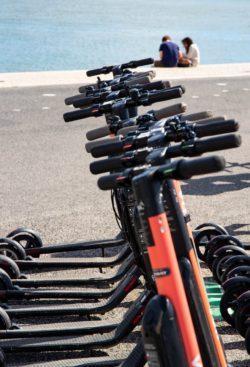By Lloyd Alter
The “last mile problem” was first described in terms of telephone wires – the most costly lines were the ones that served the individual homes. According to Stigo of the Urban Travel Blog, it then became popular in shipping circles, referring to the cost of delivering goods. It’s a big deal right now, as Amazon tries to deliver all those Prime Day orders.
But the last mile problem that directly affects most of us is the way we get home or to the office, the last little bit that we do on our own. It was relatively easy with a car, which could travel in a driveway as easily as on the highway. But as Stigo notes, that is not always so simple.
The last mile problem, at its core, is quite a simple one — public transport doesn’t take us exactly where we need to go, parking is not always available everywhere we go, owning a car or any kind of vehicle is not always possible or even reasonable. And walking is not always the quickest or the most convenient way to move around the city.
Today, everybody is trying to solve the last mile problem with all kinds of new technologies. Most people know about the e-scooters purported to be begriming cities, But there are lots of others; David Pierce of the Wall Street Journal recently tried a few of them as a solution to the last-mile problem.
To qualify as a last-mile vehicle, at least by my criteria, a device has to be light enough to carry up a flight of stairs and small enough to stash under a cafe table. It has to be easy enough to ride that you can traverse a crowded street without injuring yourself or some unlucky pedestrian. Its battery should last at least 10 miles, ideally enough to get through your commute and a meeting or two. Last, and maybe most important, it has to get you where you’re going without leaving you sweaty. Bikes, while obviously great commuting vehicles, don’t count as last-mile vehicles. Even electric bikes force you to work a little, and they are too big and heavy to carry into your meeting.
So, instead, he tries scooters, boards, Segways, some crazy skates, and his favorite, a OneWheel Pint, a strange device that he calls the unicycle of boards.
I have this theory that eventually all the scooter companies will improve their products’ durability and stability by adding bigger wheels, a seat and pedals. https://twitter.com/mtsw/status/1149196298047741952 …
Michael T Sweeney@mtswReplying to @mtswThey’re getting very close but the scooters that are solid enough for a fast comfortable ride are still pretty clunky
Bird is launching an electric moped this summer
Up to 50 miles per charge, but no word on pricing or top speed
theverge.com
I am not convinced about all these little electric alternatives. Wheels give you stability, pedals give you additional power, and bike share systems let you travel short distances. I think that Doug is right, that in the end they will all evolve into some form of bicycle. And furthermore, what is wrong with having to work a little? Why do you have something moving you every second, every foot you travel? Even Pierce comes around to this eventually.
Want to look not entirely uncool? The skateboard has the most street cred among this nerdy crowd. Need maximum portability? Pray for new, better skates. Is your only goal to go as far as possible, as fast as possible? None of these devices can outrun the Boosted Rev [electric scooter]. But if you’re already going that bulky, maybe an electric bike like the $2,998 VanMoof Electrified X2 or the $1,298 Wing Freedom is your best bet.
But everybody already owns the best solution for the last-mile problem, and most people are quite capable of using them: feet.
A hundred years ago everyone was building streetcar suburbs, communities based around the idea that you could take a streetcar to the Main Street nearest your home and walk the last 20 minutes, roughly a mile, to your door. There are few offices in cities like New York or London that are more than a 20 minute walk from decent transit. People knew, when they were planning their day, to budget 20 minutes to walk to the streetcar.
E-scooters are a lot of fun, but ultimately, good sidewalks and safe pedestrian infrastructure are the best solutions to the last-mile problem. Bikes can solve the last three-mile problem, e-bikes perhaps the last ten-mile problem, and they need their own safe and separate infrastructure.
Get your urban design right, and you don’t actually have a last-mile problem – and you don’t need electric skates.
















